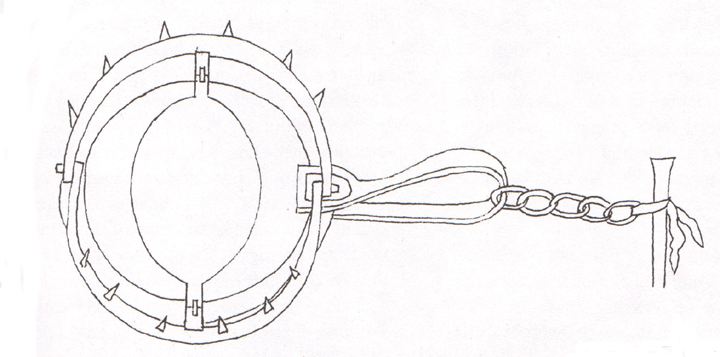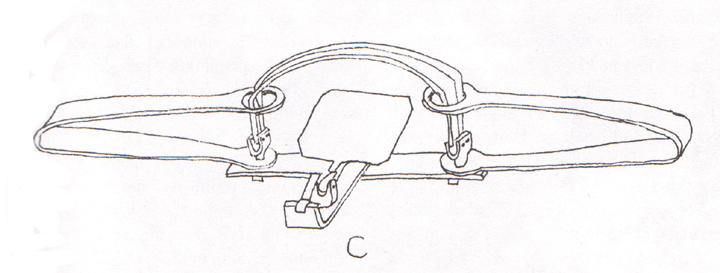Trapping
“During the French period of the fur trade, iron traps were very rarely carried into the interior before the 1750s. These items were almost never included in the equipment and trade goods that outfitters provided to traders departing from the St. Lawrence. In addition, traps or trap parts are very seldom encountered on sites dating from the French era. Therefore, it is particularly interesting to note that Cadillac transported six traps to the site of his new settlement. All of these articles were apparently about the same size and style, since they were each priced at three livres. This price reflected the degree of skill and the amount of time which had been required for their manufacture. In comparison, the iron door latch mechanisms that were shipped to the fort each cost 1.1 livres, various locks were priced from 1.5 to 1.9 livres apiece, an entire dozen of large butcher knives cost 3.75 livres, and a carbine was valued at 6.5 livres.
In spite of their great rarity in the interior regions of New France, traps made of iron and steel were certainly not rare in France at this time. Such mechanisms had been well established since at least the latter 1500s; detailed drawings of iron traps from that era were published in 1590. During the century before Ft. Pontchartrain was founded, a number of books about trapping had been published in France, and highly developed iron traps had been readily available there. Fox-sized versions which were utilized in France were discussed in a book that was published in 1608, and in another volume of 1616. Figure 69A shows an iron trap that was illustrated in François Fortin’s trapping manual of 1660. He indicated that such items were available at that time from iron workers and merchants everywhere.

Figure 69a. French trap from Fortin’s trapping manual of 1660; redrawn after Fortin.
A century later, Diderot portrayed in his Encyclopédie a nearly identical French trap (Figure 69B), and explained its operation. When the two jaws were separated and lowered, the top portion of the steel V or U-shaped spring was forced downward. The jaws were then held in the spread position by a lug which projected from the inner curve of each jaw. Over these two lugs were positioned two L-shaped posts that rose from the ends of the beam running across the flat face of the pan. (The pan, with its transverse beam and two upright posts, is shown in the Figure in both its usual position at the bottom of the trap, and also separately for clearer visibility.) The ends of the beam pivoted in two holes in the base of the trap. When an animal depressed one side of the pan, the L-shaped posts swung off the lugs of the jaws, freeing them to fly upward by the pressure of the rising spring. The animal was then captured between the toothed edges of the two jaws.

Figure 69b. Similar version depicted by Diderot in the 1750s; redrawn after Diderot. The pan, with its projecting swivel point at each side and two upright posts that rested upon the two jaw lugs when set, is shown in both its usual position at the bottom of the trap and also separately.
During the 1750s, traps which were equipped with a more reliable triggering mechanism were introduced in considerable numbers by British/American traders into the Great Lakes region and the areas west of the Alleghenies (Figure 69C). These items appeared in the records of a number of traders during that decade. After the jaws of this style of trap had been spread downward, a narrow iron strap or dog was rotated over the middle of one of the lowered jaws into a horizontal position. Then the flat pan was raised, allowing the end of the dog to fit into a notch at the end of a bar projecting from one side of the pan. When the pan was depressed by an animal, the notch moved away from the end of the dog, which flipped outward as the jaw rose upward from the pressure of the spring. A trap of this style was excavated some ninety miles north of Detroit at the Fletcher native site, which was occupied from about 1740 or 1750 to 1765; the device had probably been imported by British/American traders. In addition, broken portions of three V or U-shaped trap springs were found at Ft. Michilimackinac (1715-1781). The form of these latter springs is not diagnostic of a particular style of trap.

Figure 69c. British style of trap, with a more reliable trigger mechanism, which was introduced into the Great Lakes region and west of the Alleghenies during the 1750s; redrawn after Russell.
The increased usage of iron traps during the last decade of the French era was documented by Alexander Henry, one of the very first of the British and American traders to enter the upper Great Lakes area in 1761, immediately after the French regime had ended. He recorded in the following manner a native practice which had already become established before his time: “There are beavers, called by the Indians old bachelors, who live by themselves, build no houses, and work at no dams, but shelter themselves in holes [in the riverbank]. The usual method of taking these is by traps formed of iron or logs, and baited with branches of poplar.” In February of 1761, Sir William Johnson, the British Superintendent of Indian Affairs in North America, composed A List of Indian Goods as Are Usually Wanted and Bought, to suggest which articles ought to be transported by British and American newcomers to Detroit for trading. He included among the goods “beaver and fox traps.” It is clear from period documents and numerous excavations that the six iron traps which Cadillac brought to Ft. Pontchartrain in 1701 preceded by about five decades the serious usage of such mechanisms in the region.
Although iron traps began to gain some popularity in the interior regions during the final decades of the French period, in earlier decades nearly all trapping was carried out there by using pit traps, deadfall traps, and snares, whether the hunters were native or French. These traditional native methods were not appreciable altered by the introduction of French trade goods. Iron axes and knives only facilitated the production of wooden trap parts and the cutting of tree roots while digging pit traps. However, the switch from traditional native cordage to copper, brass, or iron wire for the noose portion of snares was a decided improvement in materials. These metal versions could not be chewed through by inquisitive animals, and they could withstand greater force without breaking, while a capture animal struggled to free itself. Compared to an iron trap, these inexpensive nooses could be easily constructed and repaired by each hunter; they also took up very little space in a shoulder bag, pack, or canoe, and weighed almost nothing. In contrast, the expensive iron traps were heavier, bulkier, and often required a blacksmith to be repaired.
Two sources of potential snare wire were listed on the 1701 cargo manifest and the 1711 inventory of the commandant’s possessions at Detroit. The former list included fifty bundles of fishhook leaders of brass, while the latter roster contained 8 ¼ pounds of fine brass wire. Other consignments of goods which were sent into the interior in this period also included wire. For instance, one bundle of iron wire weighing 4 ½ pounds was shipped in 1701 from France to the new Gulf Coast colony. The following year, Fr. Gravier requested for his missions in Illinois “3 dozen spools of fine iron wire, or else a roll of fine iron wire.” The spools that he mentioned were probably thin, flat cards of wood; an example of this type of spool, which held wrappings of decorative binding tape, was excavated in the 1760 wreckage of the ship Le Machault. In 1731, the Montreal outfitter Monière supplied 2 ½ pounds of thick brass wire to Ft. Ouiatenon, as well as one pound of fine brass wire and 4 ½ pounds of iron wire to the Sioux post on the Upper Mississippi. The following year, a consignment of merchandise that a trader imported to Ft. Pontchartrain contained 2 pounds 2 ounces of brass wire, as well as 1 pound 12 ounces of “untwisted [iron] wire;” these two versions cost 5 and 1.5 livres per pound, respectively. There is a distinct possibility that the expensive brass version consisted of two strands twisted together. In 1736, the very small amount of trade items that were brought to the fort by a voyageur included 0.55 livre worth of iron wire. Both of these types of metal wires were distributed at the trading store of the Huron mission across the river from Detroit. In 1747, the priest recorded in his ledger a transaction of 1 ¼ pounds of “iron and brass wire, both thick and thin.”
Brass, copper, and iron wire have been found in small amounts on many interior sites which date from the French period. Brass or copper versions predominate, but this may simply reflect the much better preservation rates of these metals compared to that of iron. Both brass and iron wires have been excavated at the Tionontate/Huron site at the Straits of Mackinac. Specimens that have been recovered from various sites often have diameters that range from about 3/64 to 1/16 inch. In many cases, the wire had been fashioned during its period of usage into ornaments of various types; however, pieces of single strands and sections of wires twisted or braided together may represent possible snare usage. Examples of both of these versions have been found at Ft. Frontenac, and records of Montreal outfitters indicated that they provided both single-strand and multiple-twisted-strand varieties to traders.
It is to be noted that an intact snare noose made of brass wire was found in the Basswood River along the Minnesota-Ontario border, in association with a large amount of other fur trade artifacts dating from the 18th or 19th centuries. The noose, consisting of a slender wire with a 1/8 by ¼ inch loop and a twisted segment at each end, measures 18 inches in length; the two twisted areas are 1 ½ and 3 inches long.
One game bag was included among the hunting and trapping equipment that was sent to Detroit in 1701. Such an article, made of leather or strong linen fabric, hung behind the hunter on a long shoulder strap or a waist belt. It held small game that was either killed or removed from traps during the course of a trip on foot. A French example that was portrayed by Diderot during the 1750s is presented, with its waist belt, in Figure 146 No.5 in the clothing chapter.”
